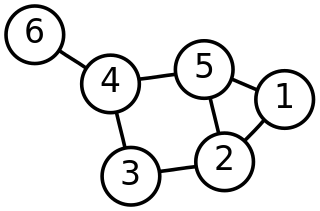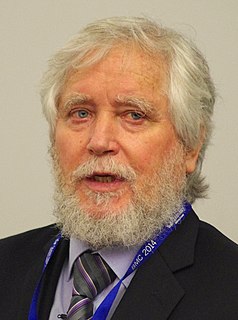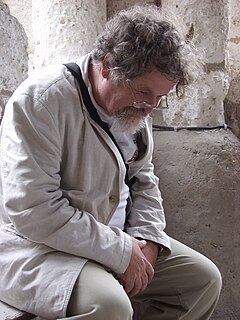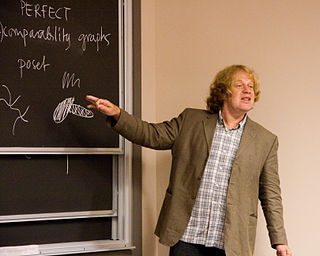Related Research Articles
Combinatorics is an area of mathematics primarily concerned with counting, both as a means and an end in obtaining results, and certain properties of finite structures. It is closely related to many other areas of mathematics and has many applications ranging from logic to statistical physics and from evolutionary biology to computer science.

Discrete mathematics is the study of mathematical structures that are fundamentally discrete rather than continuous. In contrast to real numbers that have the property of varying "smoothly", the objects studied in discrete mathematics – such as integers, graphs, and statements in logic – do not vary smoothly in this way, but have distinct, separated values. Discrete mathematics therefore excludes topics in "continuous mathematics" such as calculus or Euclidean geometry. Discrete objects can often be enumerated by integers. More formally, discrete mathematics has been characterized as the branch of mathematics dealing with countable sets. However, there is no exact definition of the term "discrete mathematics." Indeed, discrete mathematics is described less by what is included than by what is excluded: continuously varying quantities and related notions.

Ronald Lewis Graham was an American mathematician credited by the American Mathematical Society as "one of the principal architects of the rapid development worldwide of discrete mathematics in recent years". He was president of both the American Mathematical Society and the Mathematical Association of America, and his honors included the Leroy P. Steele Prize for lifetime achievement and election to the National Academy of Sciences.

Béla Bollobás FRS is a Hungarian-born British mathematician who has worked in various areas of mathematics, including functional analysis, combinatorics, graph theory, and percolation. He was strongly influenced by Paul Erdős since the age of 14.

Endre Szemerédi is a Hungarian-American mathematician and computer scientist, working in the field of combinatorics and theoretical computer science. He has been the State of New Jersey Professor of computer science at Rutgers University since 1986. He also holds a professor emeritus status at the Alfréd Rényi Institute of Mathematics of the Hungarian Academy of Sciences.
The Center for Discrete Mathematics and Theoretical Computer Science (DIMACS) is a collaboration between Rutgers University, Princeton University, and the research firms AT&T, Bell Labs, Applied Communication Sciences, and NEC. It was founded in 1989 with money from the National Science Foundation. Its offices are located on the Rutgers campus, and 250 members from the six institutions form its permanent members.

Jaroslav (Jarik) Nešetřil is a Czech mathematician, working at Charles University in Prague. His research areas include combinatorics, graph theory, algebra, posets, computer science.

Václav (Vašek) Chvátal is a Professor Emeritus in the Department of Computer Science and Software Engineering at Concordia University in Montreal, Quebec, Canada and a Visiting Professor at Charles University in Prague. He has published extensively on topics in graph theory, combinatorics, and combinatorial optimization.

In graph theory, boxicity is a graph invariant, introduced by Fred S. Roberts in 1969.
Peter Ladislaw Hammer was an American mathematician native to Romania. He contributed to the fields of operations research and applied discrete mathematics through the study of pseudo-Boolean functions and their connections to graph theory and data mining.
In graph theory, a strong orientation of an undirected graph is an assignment of a direction to each edge that makes it into a strongly connected graph.
Ronald Cedric Read was a British mathematician, latterly a professor emeritus of mathematics at the University of Waterloo, Canada. He published many books and papers, primarily on enumeration of graphs, graph isomorphism, chromatic polynomials, and particularly, the use of computers in graph-theoretical research. A majority of his later work was done in Waterloo. Read received his Ph.D. (1959) in graph theory from the University of London.

János Pach is a mathematician and computer scientist working in the fields of combinatorics and discrete and computational geometry.
Combinatorics on words is a fairly new field of mathematics, branching from combinatorics, which focuses on the study of words and formal languages. The subject looks at letters or symbols, and the sequences they form. Combinatorics on words affects various areas of mathematical study, including algebra and computer science. There have been a wide range of contributions to the field. Some of the first work was on square-free words by Axel Thue in the early 1900s. He and colleagues observed patterns within words and tried to explain them. As time went on, combinatorics on words became useful in the study of algorithms and coding. It led to developments in abstract algebra and answering open questions.
András Hajnal was a professor of mathematics at Rutgers University and a member of the Hungarian Academy of Sciences known for his work in set theory and combinatorics.
Combinatorial physics or physical combinatorics is the area of interaction between physics and combinatorics.

Michel Marie Deza was a Soviet and French mathematician, specializing in combinatorics, discrete geometry and graph theory. He was the retired director of research at the French National Centre for Scientific Research (CNRS), the vice president of the European Academy of Sciences, a research professor at the Japan Advanced Institute of Science and Technology, and one of the three founding editors-in-chief of the European Journal of Combinatorics.

Applied mathematics is the application of mathematical methods by different fields such as physics, engineering, medicine, biology, finance, business, computer science, and industry. Thus, applied mathematics is a combination of mathematical science and specialized knowledge. The term "applied mathematics" also describes the professional specialty in which mathematicians work on practical problems by formulating and studying mathematical models.
Ebadollah S. Mahmoodian is a retired professor of Mathematics at the Mathematical Sciences Department of Sharif University of Technology.
Nathaniel Dean is an African-American mathematician and educator who has made contributions to abstract and algorithmic graph theory, as well as data visualization and parallel computing.
References
- 1 2 3 4 5 Curriculum vitae [ permanent dead link ] from Roberts' web site, retrieved 2010-02-16.
- ↑ Fred Stephen Roberts at the Mathematics Genealogy Project.
- ↑ Roberts, F. S. (1969), "On the boxicity and cubicity of a graph", in Tutte, W. T. (ed.), Recent Progress in Combinatorics, Academic Press, pp. 301–310, ISBN 978-0-12-705150-5 .
- ↑ Books authored by Fred S. Roberts, retrieved 2010-02-16.
- ↑ Fishburn, Peter C. (1981). "Review of Measurement theory: with applications to decisionmaking, utility, and the social sciences by Fred S. Roberts" (PDF). Bull. Amer. Math. Soc. (N.S.). 4 (2): 233–235. doi: 10.1090/s0273-0979-1981-14893-x .
- ↑ Books edited by Fred S. Roberts, retrieved 2010-02-16.
- ↑ Fred Roberts receives NSF Science and Technology Centers Pioneer Award, retrieved 2010-02-16.
- ↑ Conference on Applications of Discrete Mathematics and Theoretical Computer Science, retrieved 2010-02-16.
- ↑ List of Fellows of the American Mathematical Society, retrieved 2013-07-07.